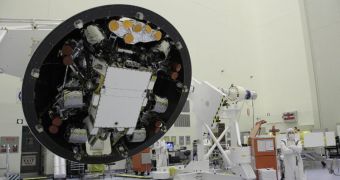Officials with the American space agency announce that the Mars Science Laboratory (MSL) mission is currently meeting all launch preparation requirements on schedule. A rocket carrying the mission is scheduled to take off towards the Red Planet in a couple of weeks.
The MSL has already been encapsulated in its protective payload fairing, which has itself been attached to the Atlas V delivery system which will take the entire ensemble to Earth's orbit. The rocket is now located at the Cape Canaveral Air Force Station (CCAFS), in Florida.
Everyone at NASA is extremely nervous about this mission, since it embodies a number of firsts in space exploration, and contains many unknowns. Chief among them is the Sky Crane system, which was developed specifically to place the Curiosity rover on the surface of Mars gently.
The machine weighs nearly a ton, and is about the size of a Mini Cooper, experts explain. As such, conventional deployment methods such as the ones used for the NASA Mars Exploration Rovers were deemed to be insufficient.
Now that everything is set in place, all that mission controllers are left with is issues orders for engineers to check, double-check and triple-check everything. The MSL has already passed all tests successfully, and is as ready to launch as it will ever be.
MSL and Curiosity will play an important role in boosting our understanding of how the Red Planet functions, as well as of how its climate changed billions of years ago. The mission will determine whether life was ever possible on our neighboring planet or not.
“We have been studying the planet as a whole with our orbiters, and with recent rovers we've been following evidence of water on the surface,” NASA Jet Propulsion Lab (JPL) deputy project scientist Ashwin Vasavada explains.
“This rover is the first to address the next goal, which is to search for habitable environments. We're landing on a place that has the potential to have been habitable in the past, one that could have supported life, and we want to understand whether that actually was the case,” the expert adds.
This year's launch window towards Mars opens up at November 25, and concludes on December 18, giving NASA ample time to launch the mission. The first takeoff attempt is scheduled for 10:25 am EST (1725 GMT), on November 25.
“Space is still a risky business. There are no guarantees in exploring Mars and there are some new technologies on this spacecraft that haven't been used before,” Vasavada concludes, quoted by Space.

 14 DAY TRIAL //
14 DAY TRIAL //